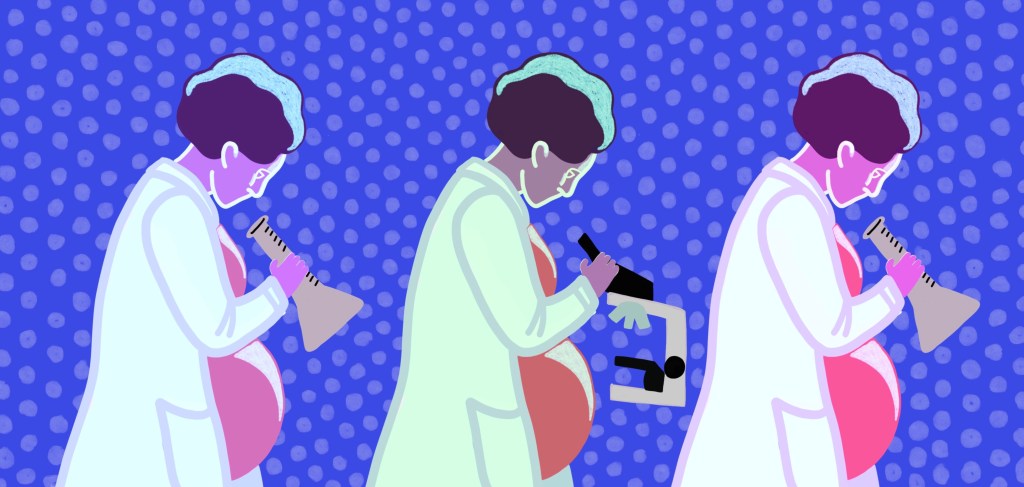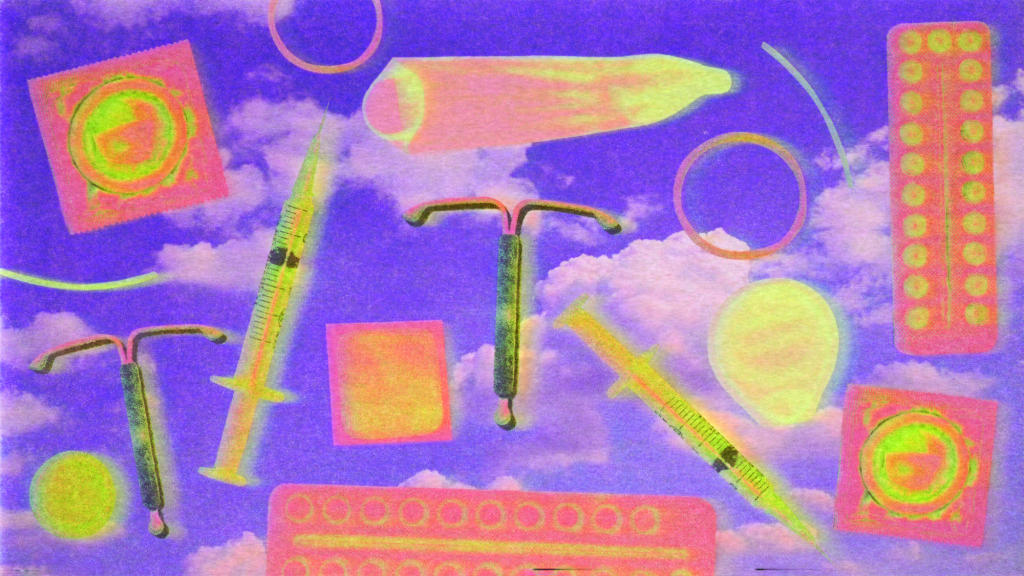There are lots of conversations about the lack of diversity in science and tech these days. Along with them, people constantly ask, “So what? Why does it matter?” There are many ways to answer that question, but perhaps the easiest is this: because a homogenous team produces homogenous products for a very heterogeneous world.
Welcome to the first installment of the reboot of Design Bias, a Motherboard column in which writer Rose Eveleth explores the products, research programs, and conclusions made not because any designer or scientist or engineer sets out to discriminate, but because the “normal” user always looks exactly the same. The result is a world that’s biased by design. -Editor
Videos by VICE
Melanie Nelson was working at a small biotech firm when she got pregnant with her second child in 2009. During her first pregnancy, Nelson was working at a contracting firm, and didn’t have much to worry about when it came to workplace safety. But this time she was working near chemicals she believed could pose a risk to her pregnancy.
“The company had a policy that anyone who got pregnant should disclose immediately to HR,” Nelson, a scientist living in California, told me. “I was in middle management there, so I followed the policy.”
Many people might balk at having to disclose a pregnancy as soon as they know about it, for all sorts of reasons. Nelson says that for her, that wasn’t the troubling part. “The nice thing was that HR then arranged for a consultation with our safety consultant,” as the firm was not of a size at the time to have that function in-house, she explained. “The less nice thing was that the consultant really couldn’t tell me anything useful, because there wasn’t any real reproductive toxicology data on any of the relevant chemicals.”
Nelson was extra worried, she said, because the company had just started working with some highly toxic anti-cancer compounds. And what’s more, the safety guidelines hadn’t been updated. “I remember thinking that some of the other committee members were pretty cavalier about the worry,” said Nelson, speaking of the group (herself included) the firm tasked with writing those new procedures. “I don’t think they meant to be, but they just didn’t think about the fact that there might be pregnant people who could be exposed to the chemicals.”
Nelson hadn’t told anybody other than HR about her pregnancy, and she didn’t want to. But as a biochemist she knew that the compounds in question could be harmful, even lethal, to a developing fetus. In those committee meetings, she tried to argue that the chemicals should be treated more carefully than other people had suggested.
Luckily for Nelson, she had an ally in the department head, who backed her up and suggested they take extra care with the new compounds, and she was happy with the safety guidelines they landed on—the child she was pregnant with at the time is now a happy, healthy eight-year-old. But the whole scenario was a stark reminder that without Nelson and her department head speaking up, the outcome could have been dangerously different.
*
Nelson’s experience using her own expertise to evaluate safety concerns while pregnant is incredibly common. Pregnant people in labs across the country get conflicting information, if they get any at all. There’s very little good research on the reproductive risks of many lab chemicals. And sometimes what individuals are advised to do could harm their career.
The problem is by no means confined to labs, of course. There is a dearth of research and data points on how all kinds of chemicals and drugs impact pregnant populations and fetuses generally. That’s in part because the ethics of experimenting on pregnant women are so fraught that it’s difficult, if not impossible, to perform a large-scale controlled study on a pregnant population. This leaves tons of uncertainty about how various substances affect these people and fetal development. For even very widely used chemicals and drugs like over-the-counter painkillers, there just aren’t a lot of good answers.
In the lab setting, however, where people like Nelson are working with chemicals that most of us wouldn’t interact with on a day-to-day basis, the problem is aggravated. And when it comes to reproductive health and safety in the lab, every research institution has its own policy.
Most universities I contacted for this story said they had some form of consultation system. Michael B. Blayney, research safety lead at Northwestern University, said that he encourages anybody who is pregnant or trying to get pregnant to meet with him to go over their risks. “What we always do is sit down with the individual and go through a list of the chemicals and materials and procedures that they are currently working with,” Blayney told me. From there, they formulate a plan for what the person should and shouldn’t do.
In an ideal world that would mean a pregnant person could contact their office of health and safety, talk to a professional, make a list of all the compounds they work with, check to see how dangerous they are for pregnant people, and come up with a clear plan for how to keep both parent and child safe.
I spoke with eight women who had gone through one or more pregnancies while working in a lab. Each of them described ways in which this ideal setup didn’t quite pan out.
“There’s very little research to look at whether these substances impact pregnancy.”
First, figuring out when and how you want to disclose your pregnancy can be a struggle unto itself. The first trimester is generally thought to be the one with the highest risk—about 80 percent of miscarriages happen in the first trimester, according to the American Congress of Obstetricians and Gynecologists. Hazardous chemicals are a concern throughout the pregnancy, but could have an outsized effect at the very beginning, precisely when many people don’t want to disclose that they’re pregnant. Blayney, for his part, emphasizes that the conversations he has with people are private; he says he does not inform an individual’s colleagues or bosses of their pregnancy or attempts to get pregnant.
That’s not the case everywhere, however. At other places, the rules about when to disclose are unclear.
Christina Bergonzo, a research chemist at the National Institute of Standards and Technology and former University of Utah postdoc, said she didn’t know what the policy was at her university’s lab. “I didn’t really get guidance from the department with respect to experiments to avoid or even what HR policies to follow,” Bergonzo said. “Everything had to be through my own inquiry.”
A university or company might have a safety policy in place for pregnant lab workers. (A spokesperson from the University of Utah directed me to this eight-point guideline for pregnant researchers, which includes listing all of the hazards “to which they might be exposed in the course of their own or a co-worker’s work,” researching those materials, and discussing any concerns with a principal investigator.) But if nobody knows about it—if Bergonzo still felt on her own—then what good does the policy do?
Even if pregnant lab workers do figure out who to talk to, that person might not have much to tell them. Some conditions, like radiation exposure, are obviously hazardous, though when it comes to the vast majority of chemicals in use in labs today, nobody can say for sure what their impact might be on reproductive health. And there isn’t much work being done to figure that out. “There is a huge reticence to study pregnant people. Or to study things that influence pregnancy,” said Kate Clancy, an associate professor of anthropology at the University of Illinois at Urbana-Champaign. “There’s very little research to look at whether these substances impact pregnancy.”
And the research that is being done often doesn’t make it into the resources offered to those actually working in the lab. The most common resource I was referred to by health and safety representatives at universities was a National Institute for Occupational Safety and Health document from 1999 that cited just six things, including cancer treatment drugs and lead, in its table of “Chemical and physical agents that are reproductive hazards for women in the workplace.” Other universities link to California’s list of chemicals known to cause cancer or reproductive toxicity, which comprises over a thousand entries but doesn’t indicate how much exposure is dangerous.
According to Blayney, this makes coming up with a plan difficult. “In a lot of cases there’s gray areas,” he said.
Often, this means that the pregnant person is using their own expertise to try and figure out their own risks. “When I found out I was pregnant, I did change the way I do a few things,” Vivianne Morrison, a graduate student at the Interdisciplinary Program in Neuroscience at Georgetown, told me. “But they were decisions made based on my own reasoning, not based on institutional guidelines. If there are any.”
*
I heard this over and over again. In the absence of any real guidance or studies, people were left to their own devices to figure out what they felt comfortable with. “I guess I trusted myself to survey the literature in this area as much as I would have trusted the safety people, whose main job seems to be to mitigate liability,” explained Kristin Rule Gleitsman, a biochemist at LumosTech, maker of a smart sleep mask.
Those who do go to their research safety representatives often find that the experts are no more informed about the risks than they themselves are. “EH&S [Environment, Health, and Safety] didn’t seem to encounter pregnant researchers a lot and so they knew about as much as I did from reading on the internet and thinking about the stuff I was using or doing,” Morrison told me.
Blayney, the research safety lead at Northwestern, said that when he’s not sure how bad something might be, he adds extra precautions. “In the absence of knowledge,” he said, “just assume the worst.”

But assuming the worst might mean changing someone’s work entirely. “Perhaps it’s just that they could stop doing that procedure, or someone else could do that procedure for them,” Blayney added. “Or they could stop a procedure and work on something more data driven or less laboratory based.”
Combined with the pressure to disclose early, this means that people who disclose in the first trimester are sometimes told to simply stop doing their research for the next nine months or more, a move that could derail their career in the competitive research environment. “They might get bumped from authorship and that can harm their chances of getting good jobs,” Clancy said. It’s worth noting that the University of Utah guidelines specifically state: “Although it is not required, it is recommended that the supervisor attempt to accommodate the employee as much as possible.”
“I shouldn’t have to make those kinds of switches in my life to be able to have kids.”
The professional risks are particularly high in labs that don’t have a culture that supports pregnancy. In fact, among the women I spoke with, the factor that most correlated with a positive experience was whether or not the head of the lab was understanding. “I was lucky in that my postdoc advisor is married to a woman who was pregnant during her graduate and postdoc studies, and continued on to be a successful professor,” said Bergonzo. “I felt that because of these experiences, he was very approachable and willing to work with me throughout.”
Clancy says she actually timed her pregnancies in part to coincide with times when she could switch her work away from the lab. “I waited until I was in the writing phase of my dissertation for my first baby, and then I wanted to be in another stage of research for my second kid.” But she doesn’t think that’s a reasonable expectation for everyone. “I shouldn’t have to make those kinds of switches in my life to be able to have kids.”
The risks and confusion doesn’t simply stop when the child is born either. Studies have shown that compounds like DDT, BPA, PBDEs (chemicals used in flame retardants), heavy metal cadmium, lead, and mercury can all find their way into breast milk. But as with safety research into reproductive hazards, there’s very little research into the details of breast milk contamination.
“Our knowledge of what gets into [breast] milk and how is really poor, so there is very little guidance available about what is safe,” Nelson said.
The Centers for Disease Control acknowledges as much, in so many words, on its website. According to the CDC, “While some women may have detectable levels of chemical agents in their breast milk, no established ‘normal’ or ‘abnormal’ levels exist to aide in clinical interpretation. As a result, breast milk is not routinely tested for environmental pollutants.”
Sometimes a lab might not even have a designated space for pumping, as Morrison says is the case in her building. “Where can I go to safely and comfortably pump to feed my baby? The answer, as it currently stands, is to go to an entirely different building.”
Pumping requires times, relaxation, and a lot of equipment, including the pump motor, tubes, nipple shields, and bottles, Morrison added. “If you’re a graduate student or research staff member, every minute of the day counts, so how do you imagine trekking to another building to pump and then trekking back to clean and store your equipment impacts daily productivity?”
*
These days, there is a lot of talk about how to create and retain diverse labs. Yet those conversations often stop simply at the hiring process and rarely address the barriers that those people, some of whom might get pregnant, might face in the future.
“You need policies that actually invite women to be part of science, not just ensure compliance and counting heads,” Clancy said. Instead, many health and safety teams seem more concerned about liability and checking off boxes for eye washes and fire extinguishers. “When we’re focused on compliance you never get a chance to ask questions like, how do these things influence breastfeeding women and is there a chance that those things could get into breast milk?”
Melanie Nelson recently pivoted from working strictly in biotech to developing scientific software. But her experience speaking up and steering the safety conversation at her former employer, while no one there knew she was pregnant, is a reminder of just how precarious these guidelines can really be. “It underscored the fact that often the people writing policies in small companies don’t really know what they’re doing,” she said.
That’s particularly true for individuals who might not be able to lean on their own scientific expertise to guide them. “As a scientist, I was able to look at the safety policies with a critical eye,” Nelson told me, while most others, including administrative and finance staff, must simply trust the sparse safety policies they’re handed. “That was a sobering thought.”
Get six of our favorite Motherboard stories every day by signing up for our newsletter.




